#transpose of matrix
Explore tagged Tumblr posts
Text
https://en.m.wikipedia.org/wiki/Initial-stress-derived_noun !
tons more examples there
Actually here’s some english shit that pisses me off. When you very slightly change how you pronounce a vowel to make a noun into a verb. This is a duplicate, which happens when you duplicate one item to make two or more.
#including “transpose”#which is only really a noun in math#and yet we automatically apply this pattern#the TRANSpose of a matrix#we transPOSE the matrix
9K notes
·
View notes
Text

1 note
·
View note
Text
Simplifying the previous adjoint matrix results.
[Click here for a PDF version of this (and the previous) post] We previously found determinant expressions for the matrix elements of the adjoint for 2D and 3D matrices \( M \). However, we can extract additional structure from each of those results. 2D case. Given a matrix expressed in block matrix form in terms of it’s columns \begin{equation}\label{eqn:adjoint:500} M = \begin{bmatrix} \Bm_1 &…
View On WordPress
#adjoint matrix#column vector#cross product#dot product#matrix#pseudoscalar#reciprocal frame#row vector#transpose#wedge product
0 notes
Text
As a math major, I am simply enchanted by the idea of Neil Josten, Math Major. Please enjoy this collection of headcanons I came up with to cope with studying mathematics.
Neil is a pure math guy. There are two big camps of mathematics: pure and applied. Applied math is about applying math to other fields (physics, engineering, finance, etc.), while pure math is like math for the sake of doing math (read: a lot less employable). Neil picking the math major because he's good at math and kind of likes it is a very Pure Math thing to do.
Neil has a whiteboard, possibly multiple whiteboards. Whiteboards are the ultimate tool of mathematics. Sometimes Neil gets stuck on a problem for hours; hunched over his mini whiteboard, working through it over and over again. His fingers get covered in the expo marker residue and it leaves a black mark when he scratches his nose. Andrew huffs that he looks like a chimney sweep and rubs it off with his sleeve (he absolutely does NOT find it adorable, shut up, Nicky). Also, around exams Neil will drag Andrew to the library so he can do his practice problems on the Big Whiteboards. The other people in the library stare at them because this little ginger is filling multiple whiteboards with weird symbols and greek letters; Neil doesn't notice because he's oblivious, Andrew notices and it makes him a smug bf.
One time one of the Foxes asks him for help with their statistics homework and he gives it a shot, because how different could it be? They both quickly find out that he knows absolutely nothing about statistics. "What IS that?" "That's a matrix, it has the variances in it." "Well then why does it have an apostrophe by it?" "That means you flip it around." "That's TRANSPOSING and you notate it with a T" "Aren't you supposed to be some kind of math genius? Shouldn't you know how to do this?" "This isn't math, this is blasphemy."
Aaron has to take calculus for the MCAT and puts it off for as long as possible because he hates math. His TA for the course sucks and he struggles through it for weeks before Katelyn manages to convince him to ask Neil for help. Neil pretends to be annoyed, but he's secretly kind of looking forward to it because calculus is fun and it's nice to do math you already know for a change. When you're an upperclassman in a math degree, though, your brain gets warped by all the theoretical math, and it's hard to get into the mindset to teach something like Calc I. This leads to semiregular hostile tutoring sessions in the dorm, we're talking real Dad Trying to Help You With Your Math Homework at the Kitchen Table type energy. "BUT HOW DID YOU KNOW TO DO THAT?!" "It's a vector space, Aaron, I don't see what you're not understanding here." "A vector WHAT" Andrew chain smokes through these. He has to start leaving the dorm because he's pretty sure the calculus is going to drive him to lung cancer.
The statistics incident gives Neil a totally reasonable grudge against statistics. He eventually gives it up, but only so he can take an elective about sports statistics, because he has exy brain worms.
#Math Major Neil the man that you are#this is a cry for help#he loves math but math does not always love him back#pure math supremacy#aftg#neil josten#andrew minyard#andreil#this is my first real aftg post and it's about math
331 notes
·
View notes
Text
A year in illustration, 2023 edition (part two)
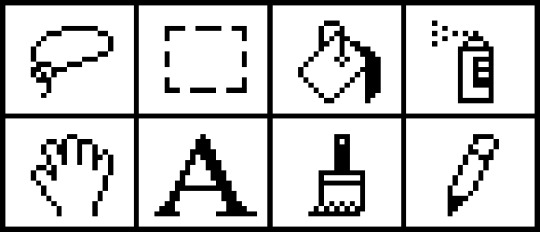
(This is part two; part one is here.)

The West Midlands Police were kind enough to upload a high-rez of their surveillance camera control room to Flickr under a CC license (they've since deleted it), and it was the perfect frame for dozens of repeating clown images with HAL9000 red noses. This worked out great. The clown face is from a 1940s ad for novelty masks.
https://pluralistic.net/2023/08/23/automation-blindness/#humans-in-the-loop

I spent an absurd amount of time transforming a photo I took of three pinball machines into union-busting themed tables, pulling in a bunch of images from old Soviet propaganda art. An editorial cartoon of Teddy Roosevelt with his big stick takes center stage, while a NLRB General Counsel Jennifer Abruzzo's official portrait presides over the scene. I hand-made the eight-segment TILT displays.
https://pluralistic.net/2023/09/06/goons-ginks-and-company-finks/#if-blood-be-the-price-of-your-cursed-wealth

Working with the highest-possible rez sources makes all the difference in the world. Syvwlch's extremely high-rez paint-scraper is a gift to people writing about web-scraping, and the Matrix code waterfall mapped onto it like butter.
https://pluralistic.net/2023/09/17/how-to-think-about-scraping/

This old TWA ad depicting a young man eagerly pitching an older man has incredible body-language – so much so that when I replaced their heads with raw meat, the intent and character remained intact. I often struggle for background to put behind images like this, but high-rez currency imagery, with the blown up intaglio, crushes it.
https://pluralistic.net/2023/10/04/dont-let-your-meat-loaf/#meaty-beaty-big-and-bouncy

I transposed Photoshop instructions for turning a face into a zombie into Gimp instructions to make Zombie Uncle Sam. The guy looking at his watch kills me. He's from an old magazine illustration about radio broadcasting. What a face!
https://pluralistic.net/2023/10/18/the-people-no/#tell-ya-what-i-want-what-i-really-really-want

The mansplaining guy from the TWA ad is back, but this time he's telling a whopper. It took so much work to give him that Pinnocchio nose. Clearly, he's lying about capitalism, hence the Atlas Shrugged cover. Bosch's "Garden of Earthly Delights" makes for an excellent, public domain hellscape fit for a nonconensual pitch about the miracle of capitalism.
https://pluralistic.net/2023/10/27/six-sells/#youre-holding-it-wrong
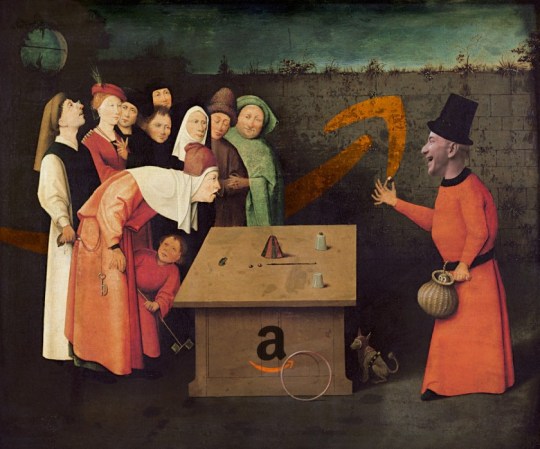
There's no better image for stories about techbros scamming rubes than Bosch's 'The Conjurer.' Throw in Jeff Bezos's head and an Amazon logo and you're off to the races. I boobytrapped this image by adding as many fingers as I could fit onto each of these figures in the hopes that someone could falsely accuse me of AI-generating this. No one did.
https://pluralistic.net/2023/11/06/attention-rents/#consumer-welfare-queens

Once again, it's Bosch to the rescue. Slap a different smiley-face emoji on each of the tormented figures in 'Garden of Earthly Delights' and you've got a perfect metaphor for the 'brand safety' problem of hard news dying online because brands don't want to be associated with unpleasant things, and the news is very unpleasant indeed.
https://pluralistic.net/2023/11/11/ad-jacency/#brand-safety

I really struggle to come up with images for my linkdump posts. I'm running out of ways to illustrate assortments and varieties. I got to noodling with a Kellogg's mini-cereal variety pack and I realized it was the perfect place for a vicious gorilla image I'd just found online in a WWI propaganda poster headed 'Destroy This Mad Brute.' I put so many fake AI tells in this one – extra pupils, extra fingers, a super-AI-esque Kellogg's logo.
https://pluralistic.net/2023/11/05/variegated/#nein
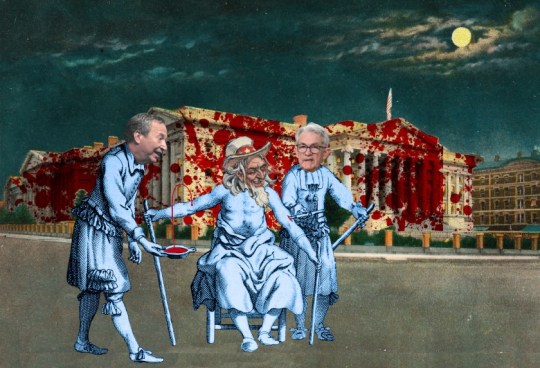
Bloodletting is the perfect metaphor for using rate-hikes to fight inflation. A vintage image of the Treasury, spattered with blood, makes a great backdrop. For the foreground, a medieval woodcut of bloodletting quacks – give one the head of Larry Summers, the other, Jerome Powell. For the patient, use Uncle Sam's head.
https://pluralistic.net/2023/11/20/bloodletting/#inflated-ego
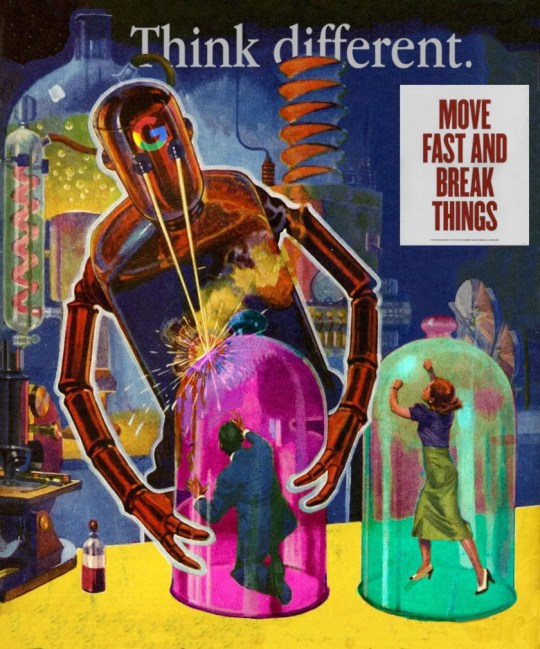
I killed a long videoconference call slicing up an old pulp cover showing a killer robot zapping a couple of shrunken people in bell-jars. It was the ideal image to illustrate Big Tech's enshittification, especially when it was decorated with some classic tech slogans.
https://pluralistic.net/2023/11/22/who-wins-the-argument/#corporations-are-people-my-friend
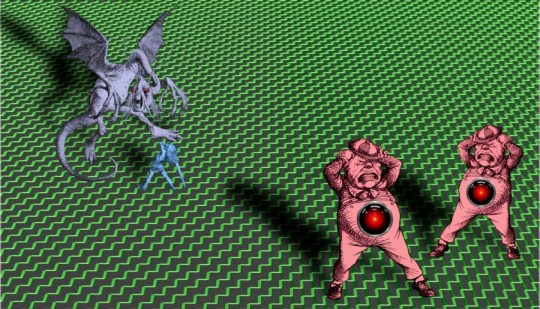
There's something meditative about manually cutting out Tenniel engravings from Alice – the Jabberwock was insane. But it was worth it for this Tron-inflected illustration using a distorted Cartesian grid to display the enormous difference between e/acc and AI doomers, and everyone else in the world.
https://pluralistic.net/2023/11/27/10-types-of-people/#taking-up-a-lot-of-space
Multilayer source images for your remixing pleasure:
Scientist in chemlabhttps://craphound.com/images/scientist-in-chem-lab.psd
Humpty Dumpty and the millionaires https://craphound.com/images/humpty-dumpty-and-the-millionaires.psd
Demon summoning https://craphound.com/images/demon-summoning.psd
Killer Robot and People in Bell Jars https://craphound.com/images/killer-robot-and-bell-jars.psd
TWA mansplainer https://craphound.com/images/twa-mansplainer.psd
Impatient boss https://craphound.com/images/impatient-boss.psd
Destroy This Mad Brute https://craphound.com/images/destroy-this-mad-brute.psd
(Images: Heinz Bunse, West Midlands Police, Christopher Sessums, CC BY-SA 2.0; Mike Mozart, Jesse Wagstaff, Stephen Drake, Steve Jurvetson, syvwlch, Doc Searls, https://www.flickr.com/photos/mosaic36/14231376315, Chatham House, CC BY 2.0; Cryteria, CC BY 3.0; Mr. Kjetil Ree, Trevor Parscal, Rama, “Soldiers of Russia” Cultural Center, Russian Airborne Troops Press Service, CC BY-SA 3.0; Raimond Spekking, CC BY 4.0; Drahtlos, CC BY-SA 4.0; Eugen Rochko, Affero; modified)
201 notes
·
View notes
Text
There is a very slight perception filter, not on the TARDIS, but emanating from the TARDIS. It's part of the translation software. For anyone receiving the benefits ---
(or perhaps curse, for how can you ever truly learn anyone else's language? How can you ever truly see the ones you love as they are? No matter how much you throw yourself into the universe, you're cut off from the true scale and magnifence of its diversity. How miserable, how utterly typical of Time Lords.)
--- of TARDIS translation, which goes both inward (your understanding) and outward (others' understanding of you), it makes the people you see, as well as the animals and plants, something you can comprehend,
Oh, it doesn't do everything. If something or someone is totally, irreconcilably foreign, they will appear irreconcilably foreign. But humanoid is, indeed, a very common template throughout the universe, like crabs, or trees. Unlike those, this particular phenomen isn't entirely natural -- the Time Lords, xenophobic and egotistical, have been subtly favoring humanoids, beings like themselves, for eternity, for all their claims of impartiality, and even once they're gone that doesn't just go away all at once. Though yes, it is starting to.
But even so, they're not all identical.
If a being is kind of humanoid, then they'll look humanoid, but a little strange.
If a being is very much humanoid, but just a little different, they'll look perfectly human. (To a human, anyway, the metric for this explanation. Just transpose this onto any other species who may be travelling in the TARDIS.)
Over time the strength of this setting gets turned down, gradually. Whether this is the Doctor's doing, or the TARDIS's, or both of them in agreement, I don't know. Also, the Doctor's TARDIS has always been a little buggy in so many respects, and no part of the translation matrix is any exception.
#this is a dr nyarlathotep post also btw#do we still call it that?#idk#dw meta#lavender thoughts#dw#dw theory#lavender writings
6 notes
·
View notes
Text
ogrumm replied to your post
Huh, are you projecting the triangles? Looks like something is getting transformed
so the way this shader works is that i manually draw a quad inside the opengl clipping box aligned right up against z = -1 at the far clipping plane, with no perspective matrix applied. and then i multiply the given points (which are just like, V3 ±1 ±1 -1) by the inverse of the perspective*view matrix to convert them into 'world space', and then i convert those to spherical coordinates to project the celestial sphere as seen from that particular point.
the actual problem in play here was that i was just transposing the view matrix when i set it. b/c i wasn't sure if my code was doing the thing i expected wrt opengl's column-major matrices. so, same exact calculations except one of these has a matrix transposed:
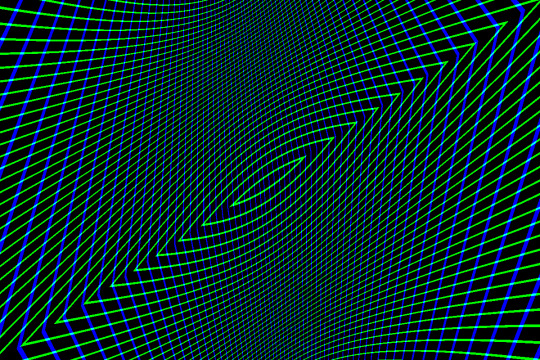
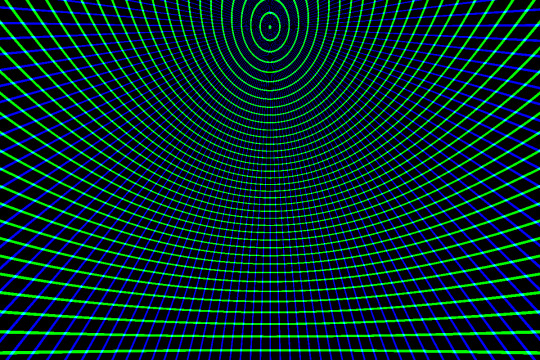
i can't say why the broken version looks precisely the way it does, just, the transposition was definitely the thing wrong there. now i have lat/long lines as expected!
4 notes
·
View notes
Text
ok today i swear i promise im gonna code some block matrix algorithms. i wanna tackle transpose first. i think the big thing is like. i know in theory how to accomplish a normal block transpose but how do you extend that to complex doubles. cause that basically halves the number of things you can store per block (i.e. per cache line)
2 notes
·
View notes
Text
Arturia Matrix-12 Download
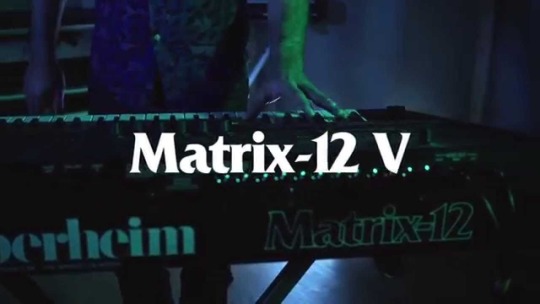
Tech Specs (MAC & Windows)
Software Type:Music Software
Platform:, MAC & Windows
Upgrade/Full Version:Full Unlocked
Download/Boxed:Download
License Type:Lifetime Activation
Format: Standalone, VST, VST3, AU
Hardware Requirements – PC:Intel / AMD Multi-core CPU, 4GB RAM minimum
OS Requirements – OSX : OS X 10.8 or later M1& M2
Arturia Matrix 12 V Virtual Synth Plug-in at a Glance:
The Matrix 12 story, in all its glory
Arturia models it, to a tee
Unleash your creativity: the sky’s the limit!
The Matrix 12 story, in all its glory
The 1980s were an important – and interesting – decade in the synth world. Polyphony was becoming de rigueur and digital synthesis was gaining a foothold with the Yamaha DX-7 and various digital samplers, while stripped-down synths like the Juno 106 and Korg Poly 6 were making synthesis available to the masses. The stage was set for Tom Oberheim – who had been designing some of the best-sounding synths for over a decade – to introduce a no-holds-barred analog synth. And so the Oberheim Matrix 12 was unleashed upon the world in 1985. It was, indeed, an all-out assault on the state of the art, with glorious sonics and tantalizing modulation possibilities, but its near-five-grand price tag put it out of reach for all but a few fortunate souls. Around 1000 units were produced, many of which are still making music to this day.
Arturia models it, to a tee
When it comes to modeling vintage analog synths, many of us immediately think of Arturia – and with good reason. Their proprietary True Analog Emulation technology (TAE) is truly amazing, and is no doubt a critical component in some of the finest virtual synths we’ve heard. For the Matrix 12 V, Arturia modeled not only the tonal aspects of the original two oscillators and their waveforms, but the 15 filter modes as well. They knew that the Matrix 12’s famously rich, complex sound was forged by its multiple filter modes and by the numerous modulation sources and destinations on tap. With nearly endless modulation-routing possibilities, you can sculpt wonderfully organic sounds not possible with other synthesizers.
Unleash your creativity: the sky’s the limit!
The Matrix-12 V is, just like its hardware predecessor, a multitimbral instrument. In Multi mode, each of the 12 notes can voice a different sound. These sounds can then be split on different zones of your keyboard, transposed individually, played unison – you get the idea! And Matrix 12 V’s elegant software interface makes configuring all this a cinch. While the original Matrix 12 was an amazing synthesis achievement, Arturia upped the ante by adding a new effects chain for additional sound processing. They also doubled the allowable number of modulations from 20 to 40, giving you even more creative options. Factor in the ability to control all of Matrix 12 V’s parameters via MIDI, letting you perform automation in your DAW, and you’ve got a total beast of a soft synth.
Arturia Matrix 12 V Virtual Synth Plug-in Features:
Multitimbral; 12-note polyphonic
Redesigned preset browser
Resizeable user interface for HD displays
Two oscillators, each with:
Triangle, sawtooth, and variable-width pulse wave with PWM
Oscillator 1 may be frequency modulated
Oscillator 2 equipped with white noise generator
Single 15-mode filter with:
Four Lowpass, three Highpass, and two Bandpass modes
Notch and Phase Shift modes
Four additional Combo filter modes
Powerful modulation matrix with 27 sources and 47 destinations
Mod sources include:
Five Envelopes and five LFOs
Four Ramp and three Track generators
Velocity, Pressure, and Keyboard Follow
Two insert effect slots with six studio-grade effects to choose from
Arturia’s amazing-sounding True Analog Emulation technology (TAE)
2 notes
·
View notes
Text

literally why. why on god's green earth would you even want to do this who the fuck CARES about the square roots of the eigenvalues of the product of a matrix and it's transpose arranged in descending order can you like get a life
4 notes
·
View notes
Text
CS1027 ASSIGNMENT 1 Computer Science Fundamentals II
It is important in Computer Science to consider memory and to use compression to reduce the amount of memory being used by a program. A matrix in linear algebra is considered symmetric if it is identical to its transpose. In other words, the element at (i,j) is the same as the element at (j,i) for all i and j in the bounds of the matrix. The diagonal (the set of elements from the top-left corner…
0 notes
Text
Switching to Mojo gave a 14% improvement over CUDA
https://veitner.bearblog.dev/highly-efficient-matrix-transpose-in-mojo/
0 notes
Text
so this is the first chill summer i've given myself thus far by only taking french. ODE sucked and i am happy it's over. with this free time, i decided to go through as much of connell's abstract and linear algebra notes as possible. i've just started the other day. it feels kind of dense, like 105 pages at 5 chapters minus an appendix:
sets / relations / functions / all the -jections / subgroups
groups / subgroups / homomorphisms / products
rings / polynomial rings / CRT / boolean rings
matrix rings / transpose / diag. / systems / determinants / trace
linear algebra / (sub-)modules / (co-)products / vector spaces / geometric det. / nilpotent homomorphisms / eigenvalues / jordan / inner product spaces / orthogonal group / diag. of symmetric matrices
~ it has an appendix of proofs (or deeper coverage).
i just finished relations and it was a weird experience despite being so early on in the notes. Hien's text (shown here) helped me immensely in a way that felt somewhat embarrassing:

it was then when i realized my thinking had been entirely wrong and that i was likely being thrown off by "equivalence", "relation", and ~ being used in ways that felt self-referential. it's as if i was fighting with the defintion instead of allowing it to define and i have no idea why, it's not something i'd typically do.
we're used to things being operated on, but if they aren't operated on, said things can still be related. this basic fact took 1 hour between me and 4o, which felt kind of bad but these things happen. i think it'd be seen as a weird choice to follow an ODE course with this but hey it's summer and i want ice cream for breakfast.
in more positive news the notes have pretty diagrams:
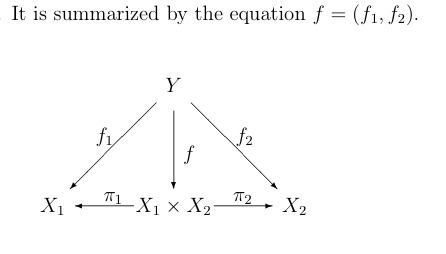
0 notes
Text
Echoes of the White Lady: A Musical and Romantic Reflection on Boïeldieu’s La Dame Blanche

I. Musical Labyrinths and Subtle Light: A Detailed Structural Analysis
While often relegated to the shadows of the standard repertory, Boïeldieu’s La Dame Blanche is a masterclass in the convergence of Classical clarity and nascent Romantic sensibility. Its musical architecture is meticulous—concealing under its folkloric surface a complex matrix of motivic development, harmonic experimentation, and orchestral nuance.
At the structural level, the opera adheres to the opéra comique form, with spoken dialogue interleaved with discrete musical numbers, yet within this constraint, Boïeldieu crafts scenes with remarkable cohesion and motivic integration. A good example is the auction scene ensemble (“D’ici voyons, l’enchère est ouverte”) in Act II. Here, Boïeldieu layers a quasi-fugal texture over an accelerating harmonic rhythm, building dramatic tension by incrementally modulating upwards by thirds—a common dramatic device in Rossini’s crescendi, but used here in a more contrapuntal, French-academic fashion. Each voice enters canonically, yet rather than following strict fugal protocol, Boïeldieu weaves motifs into loose stretto to convey the bustling atmosphere of competitive bidding.
Orchestrationally, the opera is conservative but strategically inventive. The orchestration of the overture, for instance, serves both thematic and atmospheric functions. It begins with a pizzicato string gesture beneath a soft, chromatic oboe figure—this descending chromaticism, echoed later in the flute and clarinet, introduces the so-called “White Lady motif,” which is subtly transposed and inverted throughout the opera, especially in scenes involving mystery or nocturnal imagery. The motif recurs harmonically in the form of diminished seventh chords, often resolving deceptively, imbuing the music with an air of harmonic instability and suspense.
The aria structures themselves follow Classical models—typically ternary or modified binary forms—but within these, Boïeldieu introduces modal inflections and chromatic upper neighbor tones that suggest the lingering influence of folk music. Anna’s famous aria, “Viens, gentille dame,” is deceptively simple: a rounded binary form (A–B–A’) in 6/8 with a ländler-like character. The A section is set in G major, but the harmony regularly inflects the ♭VI (E♭ major) and iiº7 (A diminished)—functioning not as pivot chords but as coloristic detours, giving the impression of spectral distance within an otherwise pastoral idiom.
A particularly striking harmonic gesture appears in the recitative-to-aria transition in Act I, when Georges first senses a mysterious familiarity with the castle. Boïeldieu modulates through a chromatic mediant progression—moving from B minor to G major to E♭ major—in a series of enharmonic reinterpretations that defy Classical tonal expectations. The strings often sustain pedal points while the wind harmonies modulate above, creating a bifurcated harmonic space that aligns with Georges’ psychological disorientation.
The choral writing is also worth noting. The villagers’ choruses frame the opera with tonal stability (usually diatonic G major or C major), serving as sonic representations of social order and tradition. These clear harmonic zones contrast starkly with the more harmonically fluid solo numbers, effectively delineating the supernatural from the real through harmonic delineation, not just thematic content.
Boïeldieu’s use of orchestral recitativo secco passages—rare in opéra comique—further anticipates later French opera. In scenes involving Anna as the White Lady, the accompaniment often shifts to tremolo strings with chromatic harp glissandi, a texture that Berlioz would later adopt and expand in Les Troyens. The harp, used sparingly but precisely, becomes a timbre of apparition, a sonic stand-in for the veil between life and legend.
In short, La Dame Blanche displays not only a refined command of Classical forms, but also a forward-looking harmonic and textural palette that straddles the cusp of Romanticism. Its intricacies lie not in bombast but in carefully constructed motifs, harmonic ambiguity, and orchestral chiaroscuro—a ghost story told in tonal twilight.
II. Through the Veil: Romantic Themes in the Storyline
At its core, La Dame Blanche is a romance about memory and spectral guardianship, cloaked in disguise, chance, and revelation. The narrative is inspired by the Scottish novels of Sir Walter Scott, particularly The Monastery and Guy Mannering, both of which are steeped in Highland legend and ghost lore. But Boïeldieu and librettist Eugène Scribe soften Scott’s gothic severity with French charm and a touch of Rousseauian idealism.
The character of the White Lady (played by Anna in disguise) is a poetic invention. Though she is not a literal ghost, her presence serves the same function: to guard a lost inheritance and guide the noble but orphaned Georges back to his rightful identity. The ghost, here, becomes a symbol of love that survives time, death, and betrayal.
There is a distinctly Romantic tension between reason and mystery. Georges, a soldier without a past, is drawn to a castle he cannot name, haunted by a lady he does not know. The moment of recognition—both of property and of love—is rendered with the sudden clarity of moonlight piercing fog. The ghost leads the hero home not only to his estate, but to his origins and his beloved.
This love story, threaded with spectral disguise and Highland mysticism, fits into a broader 19th-century fascination with female ghosts who guide, guard, and suffer—echoes of which we see in Lucia di Lammermoor, Norma, and even La Sonnambula. But Anna, unlike Lucia or Amina, is not passive. She controls the narrative, dons the mask, protects the past. She is both ghost and guardian, myth and woman.
III. Shadows in the Archive: The Legacy of La Dame Blanche
Though La Dame Blanche was a spectacular success upon its premiere—revived nearly 1,000 times at the Opéra-Comique by the end of the 19th century—its legacy has been eclipsed by more melodramatic works of Verdi and the raw psychological realism of Puccini. Today, Boïeldieu’s opera lives more in musicological memory than in performance.
Yet its influence is undeniable. Hector Berlioz admired the opera deeply, particularly for its orchestration and thematic economy. Donizetti’s Lucia di Lammermoor may owe more than a little to La Dame Blanche’s spectral woman in a Scottish castle. And the opera’s balance of spoken dialogue with supernatural overtones laid the groundwork for later hybrid forms, including Offenbach’s Les Contes d’Hoffmann.
In the 21st century, there have been attempts to revive it—most notably by Opera Rara and the Opéra Comique in Paris. But these are often academic exercises, preserved in recording more than reperformance. The ghost of La Dame Blanche haunts our operatic history not with grandeur, but with subtlety—its music a whisper of a different Romanticism, less obsessed with agony than with restoration, less with death than with remembrance.
It reminds us that operatic ghosts need not scream. Sometimes, they sing softly through harp glissandi and flutes, guarding lost estates, forgotten names, and old melodies. In an era of spectacle, La Dame Blanche invites us to listen more carefully to what lingers in the silence between notes.

youtube
0 notes
Text
"ERE"Y WORDS
◊ format the format
◊ b the NASTRAN
◊ If the F
◊ purged the multiplication
◊ solve the matrix
◊ Method: The matrix
◊ TRMEM the temperature
◊ Analysis the ECPTNL
◊ For the shape
◊ purged the identity
◊ Calculate the length
◊ solve the equation
◊ If the number
◊ whenever the vector
◊ t the thickness
◊ matrices the proportionality
◊ Manual the following
◊ When the end
◊ g. The shape
◊ number the property
◊ partitions the remarks
◊ Method: The vector
◊ column the transpose
0 notes